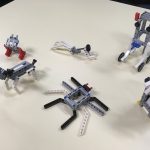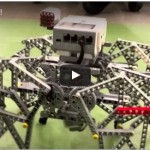A group of Tufts University students stand around a squared-off area of linoleum cheering fervently. They scream things like “Go Moosie!” and “Your buzzard’s knocking my penguin!” The whole scene seemed somewhat out of place; after all, this was an engineering lab. It all makes sense when you realize that Moosie, Buzzard, and Penguin are all robotic animals constructed entirely of LEGO pieces, and that the students were recreating their own, milder Battle Bots in an intense face-off for “symbolic food” that would make any Darwinist excited.
Students in the Robotics elective at Tufts University were given three weeks to design and build an animal of their choice using LEGO pieces as their base. The robot had to look and act like the animal while searching for food, indicated by small squares of black tape on the ground. The students were encouraged to decorate their robots to make them look more like animals, and also to add any extraneous programming that would make the animals behavior more animal-like. Feeding Frenzy was based on the activity of the same name from Eric Wang’s book “Engineering with LEGO bricks and ROBOLAB.”

In general, students chose either of two approaches to the animal project: a purist technique in which they built the animal using solely LEGO and the NXT, or a more “crafty” technique in which a variety of materials ranging from toilet paper to feathers were used to provide a “skin” for their robots. At the exhibition at the Center for Engineering Educational Outreach at Tufts University on October 16th, both of these approaches were used. In the last thirty minutes of class, instructor Erin Cejka held a “survival of the fittest” competition in which the robots were placed around the periphery of a six by six foot square with eight “food squares” in the center. As each animal found a piece of food, that piece and the animal were removed. The animal left with no food would be voted off. Here are some of our favorite projects—maybe they’ll inspire you to build some animal robots, too!
2) The Vulture: The vulture in its early stages could have hardly been identified to your average onlooker. Apart from its head, the rest of the creation didn’t even mildly resemble an actual vulture. Initially built solely out of LEGO pieces, the vulture moved on a set of 2 wheels and afront skid bar equipped with a light sensor. The head of the vulture was very distinct by using a proximity sensor not for it’s capabilities, but for its appearance as a face. Upon arriving at the activity, students proceeded to wrap their creation in toilet paper giving it a much more distinct resemblance to an actual vulture.
3) The Bug: The bug in appearance was the most simplistic of the creations. It moved on six LEGO legs equipped with rubber grippers and had no external decoration apart from tiny red LEGO bat wings. The cool part of the bug was definitely not it’s form, but it’s function. “The bug is delicate, and you should definitely not step on it,” said one of the creators as he stomped on it. As he stepped on it, not only did the bug stop operating, but small Xs appeared on the NXT screen accompanied with music giving the impression of “death”. The simple addition of a touch sensor built within the bug added this effect in turn adding a bit of creativity and originality when it came to the programming and technical side of the project. The one weakness of the bug was its speed in action. The designed motion of the legs limited it to a very slow crawl.
4) The Phoenix: The most externally decorated robot of all, the phoenix, was also a very efficient food-finder. The body of the bird, which was enveloped in red construction paper, housed the NXT unit and a wheel-driven system. The tail was created using feathers and tinsel. The phoenix was programmed to not only accomplish the task of finding food but also to resemble a real bird.
When the votes were tallied, the vulture took the gold medal finding the first piece of food in every round, followed closely by a dinosaur, with a chickadee taking third.
There was definitely some strategy involved in the tournament—many competitors turned off otherwise time-consuming features of their robots such as crying after thirty seconds of finding no food and additional otherwise cute animal behaviors. In each round, students stood around cheering for their creations, and some stubborn robots that just wouldn’t find that last piece of food definitely boosted the competitive spirit amongst the engineers.
We all know, however, that the flip side of this coin was the aesthetic—how lifelike or just plain cute the robots were. Phoenix won best in show, with Moosie following at a close second. Overall, the project (and the event) were huge successes. Students enjoyed showing off their creative sides while making use of their programming skills, having fun with their friends, and being competitive. Watch out BattleBots— you aint got nothing on LEGO engineering.
Resources
Article by Olivia Teytelbaum ( olivia@legoeng.local)
Photographs by Laura Beals
CEEO
Latest posts by CEEO (see all)
- Chair for Mr Bear - 21 August 2020
- Assistive Technology: Making Lives Easier - 20 August 2020
- Sturdy Tower - 14 June 2020
- Going the Distance - 21 May 2020
- GPS accuracy testing with LEGO bricks - 10 September 2015



